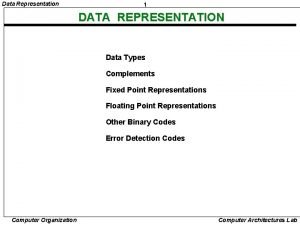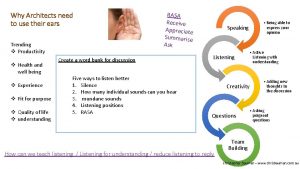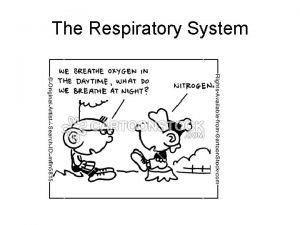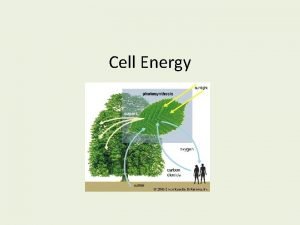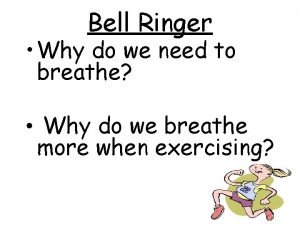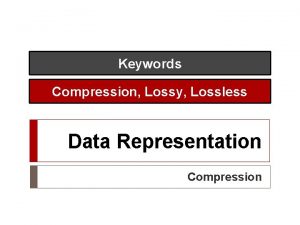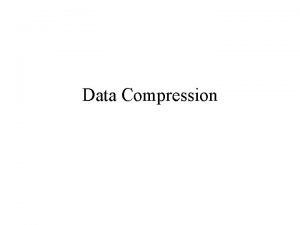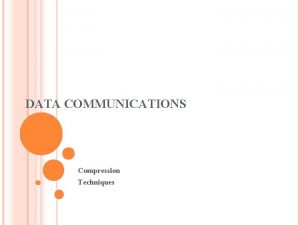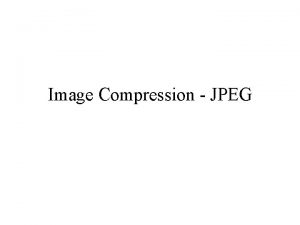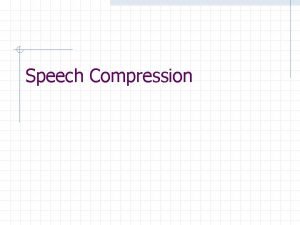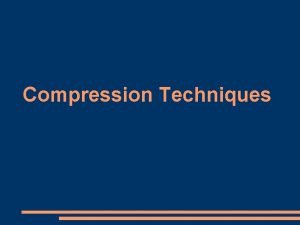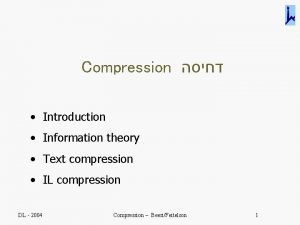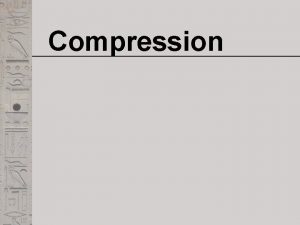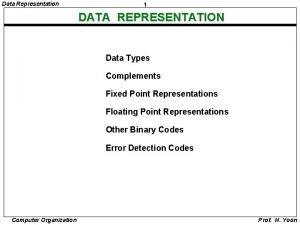Compression Data representation Compression Why do we need
















- Slides: 16

Compression Data representation Compression • Why do we need it? • What does it do?

Compression Data representation Compression • Is used to reduce the storage space that is required to store a file. • Disk space in modern computers is much cheaper and higher capacity so the need for compression has reduced. • Now used for sending files over the internet. • The reduced file size helps to reduce the amount of buffering that is required whilst retaining the original quality.

Compression Data representation Compression techniques • Reduce file size • Mostly used with sound, image and video file types • Two types: • Lossy compression (JPG, GIF, MP 3, MP 4) • Lossless compression (PNG, TIF, SVG, FLAC, WAV)

Compression Data representation Lossy compression • Permanently removes some data • Recreates the file using the remaining data and uses algorithms to guess the removed content • Uncompressed data is not the same as the original • Would this technique work for compressing a computer program?

Compression Data representation How lossy compression works • Similarly coloured pixels are all made the same

Compression Data representation Run Length Encoding • Lossless compression • counts the bits that are repeated consecutively. • rather than storing each pixel individually, the file would instead store the pixel colour and the number of times it is repeated. 2 Repeat count 3 Colour 4 2 1 3 2 1

Compression Data representation Run Length Encoding Disadvantage • If a file does not contain many repetitions then this method of compression can actually increase file size • A single pixel would be stored as its colour and then the information that it is repeated only once. 2 2 1 1

Compression Data representation Lossless text compression • Finds patterns in the original text • Encodes each pattern in a dictionary An eye for an eye, a tooth for a tooth. An_ eye _for_ an_ , _ a_ tooth 0 1 2 3 4 5 6 7 0000 0001 0010 0011 0100 0101 0110 0111

Compression Data representation Lossless text compression • 38 Characters including spaces = 38 bytes (assuming an 8 -bit ASCII table is used) • 48 bits = 12 bytes = 32% of original size (plus codes). An_ eye _for_ an_ , _ a_ tooth 0 1 2 3 4 5 6 7 0000 0001 0010 0011 0100 0101 0110 0111 1 2 3 4 2 5 6 7 3 6 7 0 0001 0010 0011 0100 0010 0101 0110 0111 0011 0110 0111 0000

Compression Data representation Transmission of data over IP • Why use compression? • Download speeds are increased • Data allowances are reduced • Voice can be transmitted fast enough to keep up with speech

Compression Data representation Downloading a music track • Dancing Queen by ABBA = 3 m 51 sec = 231 seconds • MP 3 quality = 128 kbps • 231 x 128 kbps = 29, 568 kbs / 1024 / 8 = 3. 6 MB • CD quality = 1411 kbps • 231 x 1411 kbps = 325, 941 kbs / 1024 / 8 = 39. 79 MB • 11. 5 times faster with a compressed file Improvement in bandwidth of >36 MB

Compression Data representation Benefits of compression • Smaller files = fewer packets = faster transmission • Quicker to complete • Reduces traffic over the Internet • Less chance of collisions or transmission errors • Improves download speed of video, sound (including speech used for VOIP systems) and image files • Speeds up download of webpages that use images • Reduces space on disk / servers • Enables better streaming of music and video

Compression Data representation Buffering • Video or music streaming causes buffering if the download speed is slower than the playback speed • How could you reduce the chances of people experiencing buffering if you were the website owner?

Compression Data representation Common file standards • PDF – Fixed layout document that maintains its original appearance regardless of the software used to view it • JPG – Lossy compressed files commonly used for website images • GIF – Lossy compressed images using only 256 colours, used for simple web graphics • PNG – Lossless compressed format using an alpha channel to preserve transparent backgrounds • MP 3 / MP 4 – Lossy music / video formats • ZIP - Lossless A ZIP file may contain one or more files or directories that may have been compressed

Compression Data representation Worksheet • Download this presentation and worksheet from: https: //ict 4 u. net/Computer. Science/compression. php • Complete as many of the tasks on the worksheet as you can

Compression Data representation Video • https: //www. youtube. com/watch? v=Ot. Dx. Dv. Cp. PL 4 • Huffman coding explanation is from 2: 59 6: 00
 Hey bye bye
Hey bye bye Data compression in data mining
Data compression in data mining Data types in data representation
Data types in data representation Don't ask why why why
Don't ask why why why Why architects need to use their ears
Why architects need to use their ears Why does bassanio need a loan? *
Why does bassanio need a loan? * Three living organisms
Three living organisms Why do we need to breathe
Why do we need to breathe Sources of finance
Sources of finance Why we need computer
Why we need computer Why do we need to breathe
Why do we need to breathe Why do we need arrays?
Why do we need arrays? No state can make unreasonable distinctions
No state can make unreasonable distinctions Why do cells need energy
Why do cells need energy Aerobic vs anaerobic respiration
Aerobic vs anaerobic respiration Why do tennis players need agility
Why do tennis players need agility We need to water
We need to water


